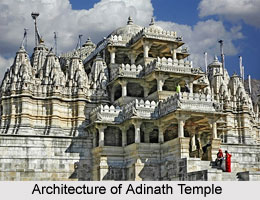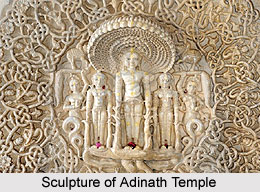 The Jain Temple of Ranakpur is dedicated to the first Tirthankara, Lord Adinath or Bhagwan Rishabh Dev. Jain Temple in Ranakpur is located at a distance of 90 km from Udaipur or 25 km from Kumbhalgarh. Adinatha Temple has been famous pilgrimage centre for its intricate and outstanding architectural style. It stands as a perfect combination of architecture, sculpture and crafts.
The Jain Temple of Ranakpur is dedicated to the first Tirthankara, Lord Adinath or Bhagwan Rishabh Dev. Jain Temple in Ranakpur is located at a distance of 90 km from Udaipur or 25 km from Kumbhalgarh. Adinatha Temple has been famous pilgrimage centre for its intricate and outstanding architectural style. It stands as a perfect combination of architecture, sculpture and crafts.
The temple was built by Seth Dharna Sah who was a Jain businessman with the help of Rana Kumbha, the ruler of Mewar in the 15th century. The temple complex is located in an isolated valley on the western side of the Aravalli Mountain Ranges.
History of Adinatha Temple
 According to history, Shri Somasundara Suriji, influenced by the sermons of the monks became an ascetic. He once dreamt of a spectacular heavenly vehicle, the nalini-gulm-vimana (lotus flight), which impressed him. He told his king that he wished construct a temple in this shape. The Rana agreed and donated land for the temple and township.
According to history, Shri Somasundara Suriji, influenced by the sermons of the monks became an ascetic. He once dreamt of a spectacular heavenly vehicle, the nalini-gulm-vimana (lotus flight), which impressed him. He told his king that he wished construct a temple in this shape. The Rana agreed and donated land for the temple and township.
However, it was quite difficult to execute the plan. There were only fifty architects to fulfil Dharna`s wish of combining the nalini-gulm-vimana with a chaturmukha-temple. Finally an architect named Depaka was called from the neighbouring village. His magnificent talent impressed Somasundara and he thus became the man who finally executed the plan.
The temple is said to having been begun in 1377 or 1387. The temple was finally inaugurated in 1441 in the presence of Dharna Shah and his teacher, Somasundara Suriji. The only source, which definitely dates to the time of the inauguration, is a forty-seven line inscription written in Sanskrit Language. This is located on a pillar to the left of the entrance. The Jain sources go back at best to the 17th or 18th century.
Architecture of Adinatha Temple
The Adinatha Temple is situated on the slope of a hill on the western flank. The plinth at the main entrance in the west has been constructed visibly higher. One can see innumerable shikhara towers, small shikharas, cupolas and pyramids soar above the ensemble.
 The Adinatha Temple has been constructed in light coloured marble that have been brought from the quarries of Sonana and Sewadi was used for the construction. The temple occupies a wide space covering an area of 48000 sq feet. There are more than 1400 exquisitely carved pillars that support the temple. The temple stands on a basement of 60m x 62m.
The Adinatha Temple has been constructed in light coloured marble that have been brought from the quarries of Sonana and Sewadi was used for the construction. The temple occupies a wide space covering an area of 48000 sq feet. There are more than 1400 exquisitely carved pillars that support the temple. The temple stands on a basement of 60m x 62m.
There are several temples like Chaumukha temple, Parsavanatha temple, Amba Mata Temple and Surya Temple. The structure of the temple is very complex. It has four different doorways that lead to the chambers. Walking through these doorways one reaches the main hall where the image of Adinath is installed. The Adinatha temple has been conceived of as a chatur-mukha-prasada, i.e., the idol faces all four cardinal directions.
At the central entrance there is a flight of stairs. On top of these stairs a three-storied "Balanaka" (entrance hall) has been constructed. It has a dome roof. Even the different columns have been carved elaborately. Apart from these, Adinatha Temple is decorated with four additional shrines. It has 24 pillared halls with 80 domes that are supported by 400 columns. The upper and lower parts of the domes have beautiful sculptures of deities. One can also see magnificently engraved nymphs playing flute in various dance postures at a height of 45 feet.
The shrines are encircled with range of cells with separate roofs. The five spires rise above the walls and around 20 cupolas rise from roof of the pillared hall. Each spire has a shrine and the largest shrine is the important one that addresses the central altar. The temple ceilings are festooned with foliate scrollwork and geometric patterns. The most striking fact about the temple is that it changes its colour from golden to pale blue after every hour during the day. There are two bells in the mandap or prayer hall that weigh 108 kg each. The harmonious sound of these bells can be heard in the temple. Because of the intricacy of the structure the temple took approximately 65 years to complete.











